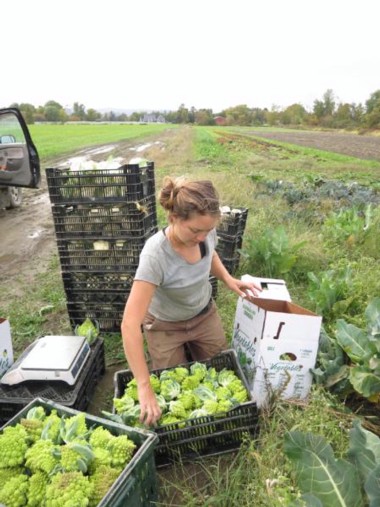It’s one of those days that only happens in the fall—clouds tumble over each other, the first colonies of fallen leaves edge the road, and the sun breaks through now and then to gild the farm fields. It’s surprisingly warm, and the road stretching into the far reaches of Sunderland’s Kitchen Garden Farm holds several near-lakes. The road feels too soft underfoot, like it’s ready to swallow up the unwary walker.
It’s harvest time, so you’d figure any farm would be mad with activity. But Kitchen Garden is not a stereotypical farm, and not one that’s focused on grand-scale production. Back near the paved road, one of the farmworkers, Laura Tupper (pictured), stood in a vegetable-crowded washing room; the yellow of her apron stood out against the bright green and rusty orange of golden beets on the washing table. The beets, she said, were heading out for a New York restaurant. She directed me to this mucky path, down which I’d find the day’s harvesting activity.
When I arrive, I wonder if I’ve taken a wrong turn at the kohlrabi. There’s no machinery in sight, no rows full of busy workers. A pleasant and low-key scene greets me, just a small truck and three young farmers. One’s barefoot, and they all seem like they’re fresh out of college. They’ve done a fair bit of work already, placing their knives between the enormous leaves to harvest heads of Romanesco cauliflower. It’s a gorgeous vegetable, if nearly extraterrestrial in its look, like a glowing, fractal version of broccoli.
It’s another sign of how untraditional a place Kitchen Garden is. The farm, owned by Tim Wilcox and (former Advocate food critic) Caroline Pam, has long catered to local restaurateurs, farmers’ markets, and its own shareholders. Its food, besides the odd truckful headed to the big city, ends up close to home. Pam trained at the French Culinary Institute, and Wilcox studied food anthropology at Hampshire College. They’re part of an intriguing Valley phenomenon, young farmers staking a claim to do things their own way, even if they don’t come from a farm family. These days, newer farms dot the Valley, invigorating the roster of long-established outposts. A lot of the newcomers raise food aimed at local buyers, and particularly discerning ones at that.
After my visit, Pam tells me why she started farming. “We are food people, and it started out of the project of growing things we wanted to cook with that weren’t available, things from our travels in places like Italy. We wanted to recreate that.”
Back in the fields, Clara Shoemaker piles Romanesco cauliflower into a box. She says Pam and Wilcox know their stuff, and their workers learn a lot about what they’re growing, too. “We all have to cook them lunch!” she says. It turns out that everybody piles in family-style for lunches, and with Pam’s and Wilcox’s help, they figure out how to cook what Tupper terms the “unique” crops they bring out of the fields.
That passing on of knowledge bodes well for the Valley’s agricultural future, and for its farmers new and old. In the Valley, Pam says, “There’s a great community of peers to learn from. A lot of my apprentices stayed and have started farms.”
As I’m walking back up the muddy road, the wind that sends the clouds tumbling brings with it a touch of autumn wistfulness. With the afternoon’s slow pace, out in the open between distant mountain peaks, it’s easy to see the appeal of standing barefoot in a field, packing vegetables under a restless sky. Pam’s words make sense: “It’s an artistic pursuit as well—[we’re] creating things of beauty.”•



